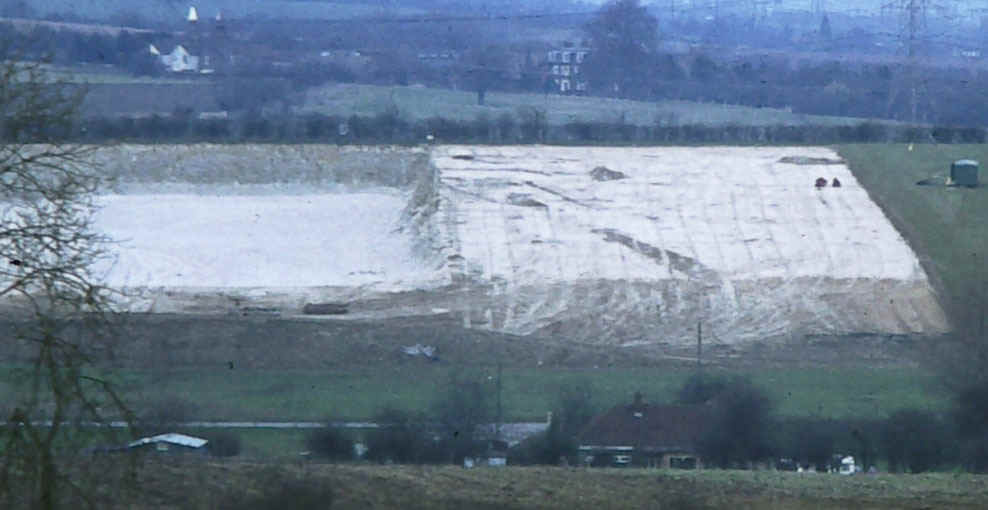|
Fawkham and Ash Archaeological Group
(FAAG)
The discovery
and excavation of a Late Iron-Age and Early Roman Farmstead at
Martin's Quarry (now
known at Pinden), Longfield, Kent 1974 and 1979 TQ6084/6842
Introduction
Rescue excavations
carried out by members of the Fawkham and Ash Archaeological Group (FAAG)
during October and November 1974 and January to April 1979, led to the
discovery of lengths of boundary ditches, pits, postholes, a cremation
burial and trackway. These were
dated by pottery to the late Iron Age and early Roman periods, and
indicated the presence of a late Iron Age and Romano-British Farmstead.
Back to
Contents Page

Martins Quarry from the South. 1974 section on
the left, worked out. 1979 section on the right with ditches showing
Discovery of the Site
Roman Pottery was
reported to have been discovered in 1953 at Martins Quarry and is listed
on the K.C.C. H.E.R. (formerly the Sites and Monuments Record) and because
of this FAAG had kept a close look out for any further extraction of chalk
at the Quarry during the 1970s.
On Monday 21st
October 1974 Ted Connell noticed, from the train, that top-soiling on a
new section had taken place. That evening Pam and Ted walked over the
site and saw a number of features, and some pottery, including four
pieces of hard, black pottery. They approached the owner, Mr Bob Gagg of
Pinden Farm, and obtained permission to observe machining the next day.
Quarry workings
had been carried out on a small scale since the middle of the 19th
century. By the 1970s, successive strips of ground approximate 36 metres wide
were being taken from the farmland to the eastern end of the open
quarry. The surface of the chalk was broken up by an agricultural disc
harrow towed by a tractor before being loaded onto lorries and sold to
local farmers for agricultural marling. This meant that any ditches,
pits etc containing soil were being emptied using a JCB digger to obtain
pure chalk.
The following
day Ted observed the continuing quarrying operations which involved
digging the soil out of the ditches and other features. He made a rough
sketch plan and retrieved more pottery and animal bones. Mr Gagg was
approached and he readily gave permission for an excavation of the
remaining features to take place before any further work continued.
Over nine days,
throughout the rest of October and November 1974, members of FAAG,
assisted by members of other local groups, excavated the remaining
features, eleven ditches, six pits and thirty one postholes.
In January 1979
a further approximate 30 metre wide area of farmland was stripped of topsoil. Once
again Mr Gagg gave permission for an archaeological excavation to take
place and members of FAAG and other local groups, led by Ted Connell,
worked on the site from January to April. 5 more ditches were
discovered, some a continuation of ditches found in the earlier 1974
excavation, 20 more pits and about 158 postholes, a hollow-way and a
cremation burial.
The remaining
available pasture to the east of the Quarry was stripped of topsoil in 1990,
being threatened by a proposed route of the Channel Tunnel Rail Link.
The whole area was top-soiled in one operation, but revealed no further
archaeological features. A field survey of the ground to the west of the
quarry in 1996 produced only 19th and 20th century finds in the form of
Willow Pattern type glazed wares and a small amount of nineteenth
century machine made tiles. Close inspection of the western face of the
Quarry revealed no archaeological features had been cut through.
Back to
Contents Page
Return
to Fawkham and Ash Archaeological Group (FAAG) Introduction |